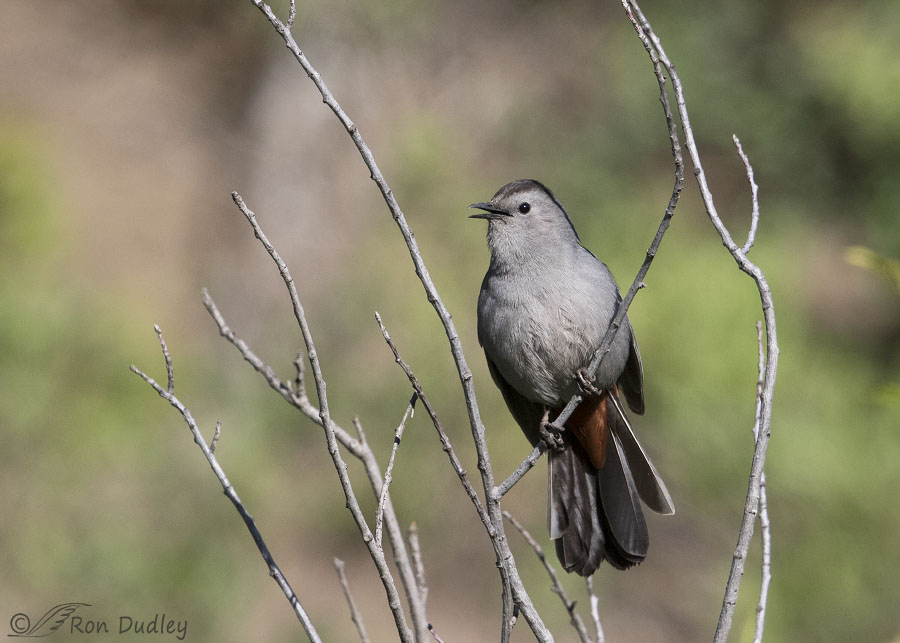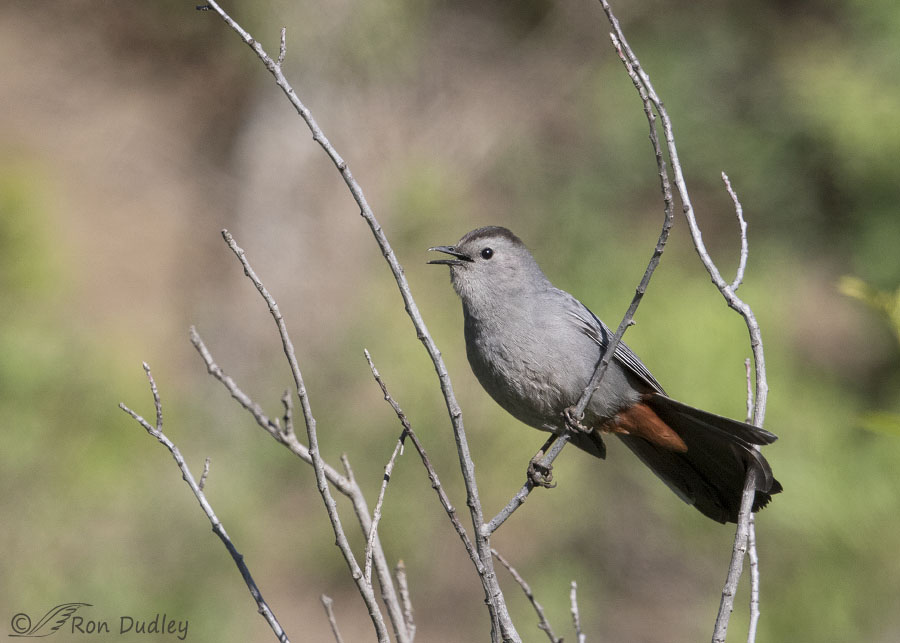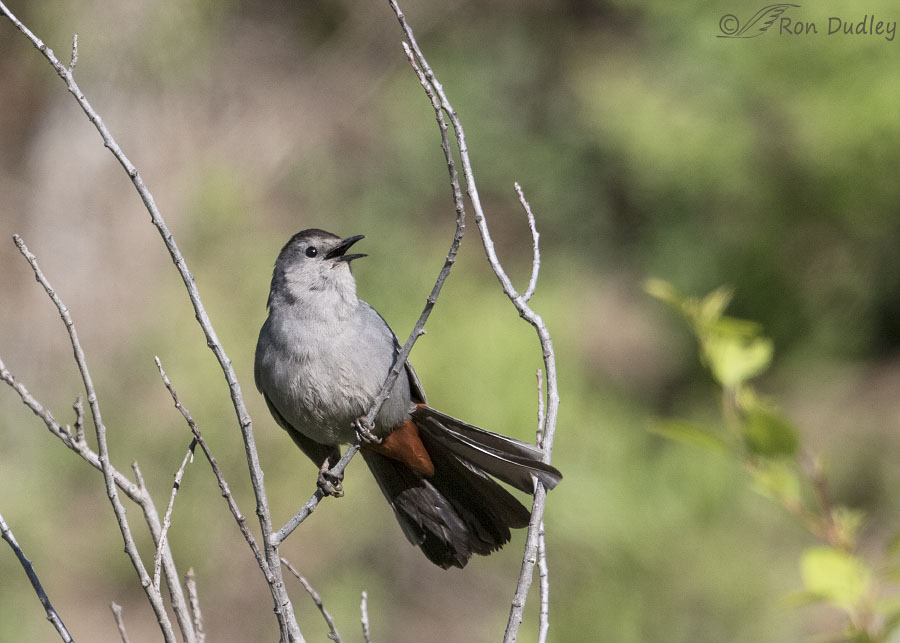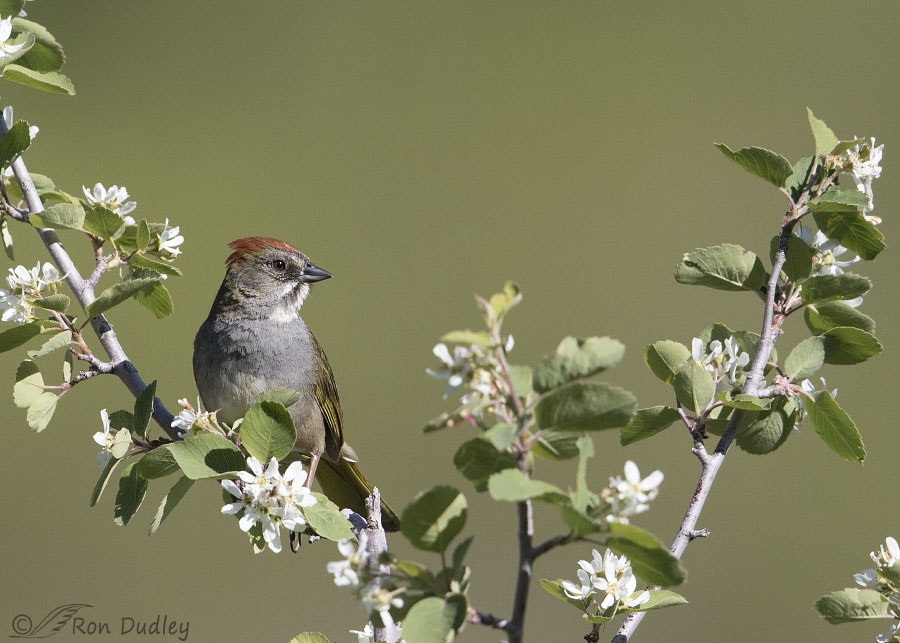A trip into the Wasatch Mountains yesterday morning provided me some photos of species I don’t often get.

1/2500, f/6.3, ISO 800, Canon 7D Mark II, Canon EF 500mm f/4L IS II USM + EF 1.4 III Extender, not baited, set up or called in
This Gray Catbird wasn’t particularly close and there were lots of twigs in the frame but I got a few clear shots while the bird was singing.

1/2500, f/6.3, ISO 800, Canon 7D Mark II, Canon EF 500mm f/4L IS II USM + EF 1.4 III Extender, not baited, set up or called in
At this angle I could see the distinctive rufous undertail coverts of the species.

1/3200, f/6.3, ISO 800, Canon 7D Mark II, Canon EF 500mm f/4L IS II USM + EF 1.4 III Extender, not baited, set up or called in
He was singing almost the entire time I had my lens on him so I presume he was a male. Gray Catbirds have considerable vocal versatility, partly because both sides of their syrinx (vocal organ) can operate independently so they can sing with two voices at the same time.
Interestingly, only about a dozen species of birds are known to recognize eggs of the parasitic cowbird in their nests and reject them and catbirds are one of them. That ability is learned and not innate.
Catbirds are extremely common in many parts of North America so I imagine many readers are ho-hum about them but in my part of Utah we’re right at the edge of their range so I’ve had very few opportunities with them. In fact this was only the second time I’ve been able to get decent photos of the species so yes I was excited to get a few fairly good shots of this one.

1/3200, f/6.3, ISO 800, Canon 7D Mark II, Canon EF 500mm f/4L IS II USM + EF 1.4 III Extender, not baited, set up or called in
A few minutes later I spent some time with this Green-tailed Towhee on a flowery perch in the beautiful mountain valley. Again the bird was at some distance and I never got any completely clear shots of him but when he looked to my right it allowed for a composition that could include more of that lovely perch. Those flowers don’t last long so this time I was happy with my timing.
I don’t often get chances with Green-tailed Towhees and they were my original “spark bird” way back in 1969 so I have a huge soft spot for them.
Ron
Note: Recently some readers have had the annoying problem of WordPress not auto-filling your name and email address in the boxes while commenting. Theoretically that issue has now been fixed. If you continue to have the problem you may need to clear your cache.


As no one’s done it yet, I feel I must comment about the Catbird’s seat. 😉
These are fantastic shots, Ron! I especially like the Towhee amongst those beautiful white flowers.
P.S. Emptied caches and still have to enter my info on my Mac laptop. No biggie — just FYI. 🙂
Ditto.
Super shots Ron! Thanks for sharing!
Charlotte
Thank you, Charlotte.
We don’t have the Gray Catbird here. I looked the bird up to hear the song. Lovely. Love all of your pics!
Thank you, Jean.
One more time
What EC said and what spectacular images (as usual). Lovely colors, lovely foliage, just overall lovely images! Thank you!
My hackles start to rise at the beginning of that pesky “it’s just a (fill in the blank, but WARNING, I get EXCEPTIONALLY cranky when you fill in that blank with “redtail.’)” phrase, and trust me, you do NOT want me to go there. What if we all celebrated the magics around us, even the ones that occur around us normally? What if?
And how cool that catbirds don’t tolerate raising other folks’ kids and kick them out of the nest before they become a problem. There’s a good survival strategy. I never knew they (or any other bird) could do that. There’s my something new for the day!
As for the blog’s technical issues, I’m up to my neck with technological technical issues! For the past three days, Windows 10, MS Outlook and IMAP have locked me out of my email, refusing to acknowledge my gmail password. I fixed it this morning by clicking SOMETHING in desperation, but I have no memory of what I could have clicked. Or maybe it healed itself?
Here, I still have to input my name and email address every time and I still don’t get a notification to confirm my follow. There’s also that issue where I SHOULD have copied my post before trying to post but didn’t. I’m going to do that now. HA! Foiled the computer bugs again!
I could go on for about another 30 minutes with technological technical issues, but in desperation, I’m going to town instead.
Oh and the catbirds’ ability to sing two songs at the same time. How cool is that?
Thank you, Laura. I know, sometimes it seems like technical issues are the bane of our existence!
What is the “cache”?
Hi Judy. The cache is where birds (and other critters) will hide food for later consumption. Birds tend to be more deliberate in where they cache food, but squirrels hide stuff all over the place, but in places where they’re likely to look later.
Judy, With computers another way of putting “clearing your cache” is to delete your temporary internet files.
‘Common’ things get overlooked and undervalued way too often.
And both of these birds are exotic wonders to me.
Thank you.
I’m glad you enjoyed them, EC. Thanks.
What a treat to see both of these species which are new to me ! I won’t know until I click “post comment” whether I’ll again have to re-enter my info, but thought that
I should mention to you that I didn’t receive this post until noon MDT, and I first opened my e-mail at about 6:30 AM, long after you’d posted…….who KNOWS what’s
going on in the electronic world these days ? Yup, had to re-enter……
Kristine, I have no idea why your email was delayed for long. I could tell by watching my stats that most folks got it in a timely manner.
Try clearing your cache to fix the auto-fill problem.
Very nice shots Ron. Regardless of the distance, you showed off the male singing in territory very well.
Interesting reading the posts. Here in Vermont Gray Catbird are spotty in appearance. Don’t have a reason why they are few and far between here. Before we moved to Vermont we had local catbirds all year long. This being a new facility is my only guess.
Thank you, Dick.
The only time I see Catbirds is when I’m in North Carolina, and I enjoy them every time I see them. My first encounter with one really impressed me: I was listening to a very hungry and unhappy cat in a swampy area, and the only creature visible was a Catbird. I’ve had a soft spot for them ever since, and have a similar one for their also common cousin, the Northern Mockingbird. Both are always fun to watch. (I am happy to report that my name and email are once again filled in for me on my Mac.)
Susan, sometimes they sound like cats and sometimes they don’t. Glad to hear that auto-fill is once again working for you.
The towhee and the flowers is a very lovely composition. And the catbird! I don’t think that I’ve seen one 😀
Thank you, Arwen.
Lovely photos…especially the Towhee…the back ground and flowers accent the bird beautifully! Got to love that rufous accent! 🙂
As an add on, if I respond with my cell phone, I’ve never had a problem but on my Mac I have to fill in the spaces…ahhh, the wonders of technology. 🙂
Thanks, Kathy. Try clearing your cache to fix the auto-fill problem.
Beautiful Ron – love the flowered perch. Nothing ho-hum here. Sibley’s shows the Catbird as rare here, and shows the Green-tailed Towhee as a summer possibility, but I have never seen either here in north-central Arizona. Like the way the photo caught the Catbird’s tail feathers.
Everett Sanborn, Prescott AZ
Everett, in the right habitats we have a fair number of both species but for me they’re generally difficult to approach.
Luckily, we have Catbirds in abundance in our area of coastal Nova Scotia, and for some reason, even more so in recent years. We always considered them a shy bird, but have found them nesting peacefully within an arms length of our garden path, in a bush very low to the ground. We have always been careful not to disturb or peer into nests, being content to know an active nest is nearby, and happy for their chosen sanctuary. I don’t know if they adapt as easily to human activity as Robins do, but they appear with cheerful confidence at this time of year. Catbirds have become a favorite of ours and although I have tried to take photos of the adult singing high up in the spruce trees (do only the males sing?) the results are limited by my present ability and equipment. As always, I am inspired by your blog, and this morning delight in the Catbird photos you have shared. Thank you. By contrast, we never see a Green-tailed Towhee and rarely an Eastern Towhee, and as their separate ranges do not extend this far east or north. They appear to be very charismatic birds as well. (Note: I just noticed the auto-fill was not working when I first posted this comment).
“do only the males sing?”
Robert, Females do sing but only rarely and at a lower volume than males.
Try clearing your cache to fix the auto-fill problem.
I don’t remember you ever posting photos of cat birds. I love when they migrate back to my yard each spring. You say they sing. In my yard they scream, at me, when my feeder is empty. They come back here every year to have their babies. I never knew that they could identify the sneaky habits of the cowbirds which I also have. These pictures just put a huge smile on my face. Thanks Ron.
“I don’t remember you ever posting photos of cat birds.”
Ellen, here’s a link to photos of the only other catbird I’ve been able to get decent shots of:
https://www.featheredphotography.com/blog/2017/08/29/gray-catbird-and-willow-flycatcher/
I love the little birds you’ve been shooting so well lately! Spring and early summer offer us all an exciting variety of birds to enjoy.
I’m curious about some birds learning to recognize and rejecting cowbird eggs. Do the catbirds recognize the baby cowbird eggs
as different after once losing their own clutch? In northern Colorado I’ve several times photographed yellow warblers struggling to
raise cowbirds. It’s sad, as I understand yellow warblers are becoming less common.
Nancy, I don’t know the answer to your question. It would be interesting to know how they learn it.
Very nice! Although Catbirds are very common here in Georgia (And now due to warmer climates stay in the northern areas year around), I never get tired of them. I lived on a spot where a male would frequently move back and forth throughout his territory, and there was one clean, exposed perch he would often sing on. They are quite impressive mimics, he would often fool the resident male Carolina wren into thinking there was another intruding male on his territory! The towhee is quite handsome as well, and I like the backgrounds on each! Great shots Ron!
Thanks, Xavier. You’re lucky to have so many around.
I didn’t realize the catbird had the rufus undertail covets. They certainly have a variety of sounds! Beautiful shots. The green towhee is also beautiful – if we have them here I’ve never noticed one…..:) Still no go today on the name fill in – perhaps another day for it to “remember”?
” They certainly have a variety of sounds!”
They sure do, Judy. This from BNA Online: “Its repertoire may include syllables of more than 100 different types varying from whistles to harsh chatters, squeaks, and even mimicry”.
Beautiful Pictures! I really enjoyed seeing the third grey catbird photo and how you captured its unique behavior and features. The bold green background combined with the texture of the bare branches and the birds peculiar position creates this marvellous scene. In the second picture, again the position of the Green-tailed Towhee reveals its full personality and the colors bring out its beauty. Also, the flowery buds mark the life of spring, wonderful picture! Well done.
Thanks very much, Daniel. Hopefully I’ll be able to get a little closer to both species before the males stop singing on territory.